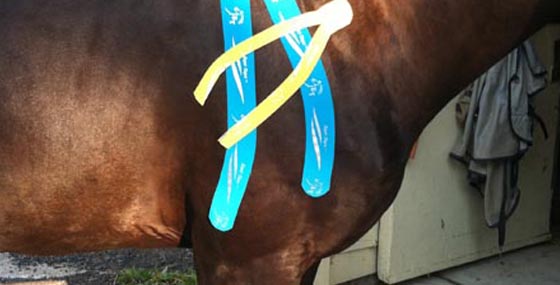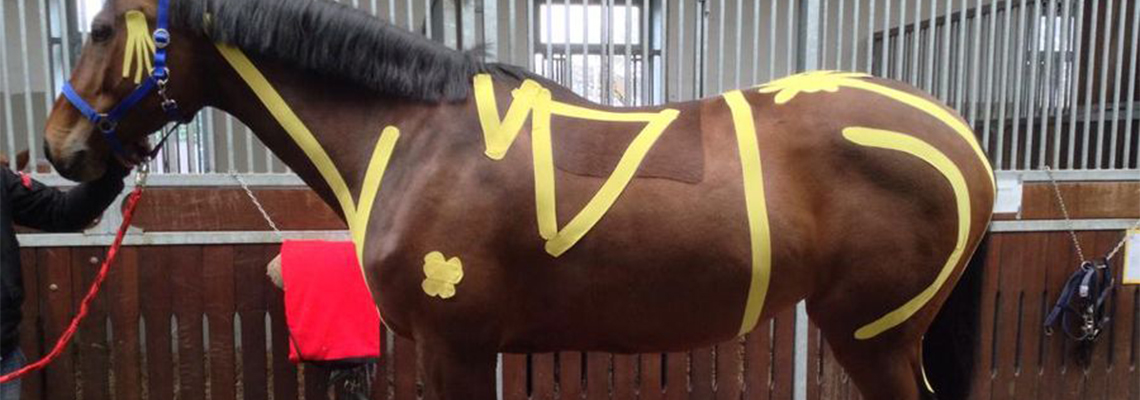Register Now! Please, fill in your personal details and we will contact you shortly
Kinesiology Taping

Audience
About the program
There are 3 parts to this training, and each part is 3 days.
Kinesiology taping applications are a breakthrough in therapy, substantially reducing recovery times and improving horses' fitness levels.
Some of the effects of equine kinesiology tapings:
• Postural and movement support – muscles, tendon and ligament problems, and unstable joints.
• Assists in positioning a muscle or joint into the proper position for rehabilitation
• Helps ROM
• Improves circulation
• Conformation asymmetries to help with posture and movement
• Muscular imbalance – tension, hypertonicity, atrophy
• Pain relief
• Scar tissue
• Fascial adhesions to help restore healthy functioning.
• Oedema and lymphatic fluid congestion
Kinesiology taping was first used on human athletes before commonly being used by chiropractors and physiotherapists with huge success. Now used on equines it provides a second skin that can either provide support and help with stabilization or can offer pain relief and aid healing, whilst still allowing mobility.
The student will learn about the concept of Kinesiology taping, an understanding of how it works, its many applications and the benefits. This is a very practical course and there will also be lots of ‘hands on time’ for the students to put into practice what they have learnt.
Today, there are more than 50 brands of kinesiology tape on the market, but the original
product, Kinesio tape or Kinesio Tex Tape, was developed in the late 1970s by Dr. Kenzo Kase, a Japanese chiropractor who wanted a tape that provided support but didn’t limit movement the way traditional athletic tapes do.
If you’ve watched a volleyball game or competitive bicycle race, you’ve probably seen it:
strips of colorful tape splayed in patterns across shoulders, knees, backs, and abs. That’s kinesiology tape: a therapeutic tape that’s applied strategically to the body to provide support, lessen pain, reduce swelling, and improve performance.
Kinesiology tape is really stretchy.
Kase created Kinesio tape with a proprietary blend of cotton and nylon. It’s designed to mimic the skin’s elasticity so you can use your full range of motion. The tape’s medical grade adhesive is also water-resistant and strong enough to stay on for three to five days.
When the tape is applied to your body, it recoils slightly, gently lifting the skin. It is believed that this helps to create a microscopic space between your skin and the tissues underneath it.
Some physical therapists think the tape changes the information your sensory nervous system is sending about pain and compression in your body.
“All of your tissues — skin, connective tissue, fascia, muscles — contain sensory receptors that feel pain, temperature, and touch. Those receptors all contribute to proprioception— your brain’s sense of where your body is and what it’s doing. Kinesiology taping creates a lift that unloads the underlying tissues. Decompressing those tissues can change the signals going to the brain.
Trigger points are a good example. Physical therapists have used kinesiology tape to lift the skin over these tense, knotted muscles. When the area is decompressed, pain
receptors send a new signal to the brain, and tension in the trigger point decreases.
A 2017 study showed that kinesiology taping can improve blood flow in the skin.
It may also improve circulation of lymphatic fluids. Lymphatic fluid is mostly water, but it also contains proteins, bacteria, and other chemicals. The lymphatic system is the way your body regulates swelling and fluid buildup.
The theory is that when kinesiology tape is applied, it creates extra subcutaneous space, which changes the pressure gradient in the area underneath your skin. That change in pressure enhances the flow of lymphatic fluid.
Changing the flow of lymphatic fluid could help bruises heal faster.
Physical therapists sometimes use kinesiology taping as one part of an overall treatment plan for people who’ve been injured. Kinesiology tape is also used to add extra support to muscles or joints that need it. Studies on athletes have shown that when kinesiology tape is used on fatigued muscles, performance improves.
Kinesiology tape can help re-train muscles that have lost function or that have gotten used to an unhealthy way of working.
Physical therapists think this may be because having the strange sensation of tape on your skin can make you more aware of how you’re standing or moving.
Although you should never use kinesiology tape on an open wound, there is some scientific evidence to suggest that kinesiology tape can improve the long-term appearance of scars after surgery or injury.
We will be using a variety of learning from classroom based to practical with a focus on learning through understanding. This is a very practically based course as the very best learning comes through hands on, the feel of the horse and how they communicate with their bodyworker. the tactile feedback is key and this is achieved through practice with a lot of support to aid understanding and progression.
The students will learn what kinesiology tape is and what it is made of and how it differs to other medical tape used historically. Students will receive a short overview of the development history from initial applications on humans to present day where it is an increasingly popular and successful treatment for equines. Recent scientific evidence-based research will also be discussed. Students will learn about the many benefits that kinesiology taping can bring about and the science behind each benefit. We will discuss the importance of evaluating and examining the equine in the first instance to gain an understanding of how and in what areas the equine will benefit from the k – taping. In practical sessions students will learn about the various applications available including muscle taping, lymphatic taping, scar taping, fascia taping, hematoma taping and taping techniques for stabilization and proprioception. The student will be shown the various tape applications followed by ‘hands on sessions’ for the students to practice.
Although a basic understanding of the equine anatomy is required training aids are provided which include diagrams of the superficial and deep muscles and the skeletal system. Revision of anatomical terminology will also be included. This is an adapted course from human kinesiology taping and knowledge of muscle insertions and origins is not required.
The course includes a variety of applications for horse and rider aimed for rehabilitation and performance enhancement. These include:
• Rider posture and injuries
• Easing muscle tension
• Stimulating muscle proprioception
• For bruising and swelling to aid recovery
• Origin / insertion application
• For tendon and ligaments to provide support, and ease strain and discomfort
• To help release superficial fascia
• To help release deep fascia
• Contra-indications and safe application
Learning Outcomes:
Understand theoretical background of the Kinesio taping Concept (human and equine)
Practical foundations of kinesiology tape and principles of applying it
Practical training in applications of taping for a variety of equine pathologies
Practical Kinesio tape application for performance enhancement

 Certificates
Certificates
(Diploma) Certificate from Al-Ahliyya Amman University – the Training and Consulting Department, the International College of Integrative Medicine (CIM), Dubai Racing Club, Dubai Equestrian Club and the International Organization for Complementary Medicine (CMA) located in London, UK, which qualifies the graduates to work all over the world.
Syllabus
DAY 1 | |
LECTURE THEORY | SUBJECT |
1 | The science behind k-taping |
2 | Effects of equine k-tapings |
3 | Methods of application |
4 | Health and Safety |
5 | How to apply tape to a horse |
6 | Procedure |
7 | Theory on muscle tapings |
LECTURE PRACTICAL | SUBJECT |
1 | Preparing the tape for various applications |
2 | Practice on each other |
3 | Demonstration of taping cuttings on horses |
DAY 2 and 3 | |
LECTURE PRACTICAL | SUBJECT |
1 | Demonstration and practice muscle tapings on horses |
DAY 4, 5, and 6 | |
LECTURE THEORY | SUBJECT |
1 | Lymphatic drainage and advanced tapings |
LECTURE PRACTICAL | SUBJECT |
1 | Demonstration and practice lymphatic tapings on horses |
DAY 7, 8 and 9 | |
LECTURE THEORY | SUBJECT |
1 | Myofascial and Neurological tapings |
2 | Discuss theory and practical assessments |
LECTURE PRACTICAL | SUBJECT |
1 | Demonstration and practice myofascial and neurological tapings on horses |
DAY 10 | |
LECTURE THEORY | SUBJECT |
1 | Final theory assessment paper |
LECTURE PRACTICAL | SUBJECT |
1 | Final practical assessments |
Register & Pay
Dean

Dr. med. Ldo. med. Álvaro Rubio
Citizenship:
Spaniard and German
FIELD OF ACTIVITY
Adult Cardiac Surgery - Cardiac Surgery Consultant
Vascular Surgery - Vascular Surgery Consultant
Pediatric Cardiac Surgery
Intensive Care Medicine
QUALIFICATION
Universitas Extrematurensis, Spain
Justus Liebig University, Germany
Cardiac Surgery Consultant - Bavarian State Chamber of Physicians, Munich/Germany
Vascular Surgery Consultant - Baden-Württemberg State Chamber of Physicians, Freiburg/Germany
Intensive Care Medicine Consultant - Baden-Württemberg State Chamber of Physicians, Freiburg/Germany
ADDITIONAL QUALIFICATION
Specialist in Radiation Protection
Certificate Clinical Homeopathy
MEMBERSHIP - SCIENTIFIC AND PROFESSIONAL SOCIETIES
CSN - Cardiothoracic Surgery Network
BDC - German Professional Association of Surgeons
DGTHG - German Society for Thoracic, Cardiac and Vascular Surgery
Association of Cardiac Surgeons
European Society of Cardiology
INVESTIGATION AWARD
The Pierre Grondin Award 2007
CMA President

Jayney Goddard, MSc, FCMA, FBSLM, Lic.LCCH, Dip.ACH, FRSPH
President - The Complementary Medical Association, London, UK
Jayney Goddard is President of The Complementary Medical Association (The CMA) which is the world's largest professional membership body for complementary medicine (CM), and she is widely regarded as one of the leading experts on complementary medicine and natural healthcare. Jayney has a vast depth of knowledge across the entire field of complementary medicine and can always be relied upon to provide substantiated research data during any interview, lecture or written work.
Jayney is a Fellow of the Royal Society of Medicine and a Fellow of the Royal Society for Public Health. She has a Master of Science post-graduate degree from the University of Central Lancashire and began her doctorate in January.
She was recently awarded the Complementary and Natural Healthcare Expo Award for Outstanding Contribution to Complementary Medicine - which was judged by a panel of respected complementary medical professionals and a group of high-profile captains of industry coming from backgrounds as diverse as banking, insurance and entertainment.
She has a busy practice (UK, USA and Skype) where she works uses a range of complementary medical approaches with her patients, including homeopathy, psychotherapy, nutrition, herbal medicine, Mind/Body medicine and hypno-analysis. Jayney's special clinical interests include auto-immune disease and natural anti-ageing/rejuvenation strategies.
Jayney is editor of "With Our Complements", the Journal of The Complementary Medical Association and she is a high-profile contributor to print and broadcast media.
Jayney is the complementary medical expert for various newspapers and magazines and is a regular guest on television and radio when expert opinion is required on any aspect of complementary medicine and natural health care. Adept at phone-in “open clinic” type broadcasts, Jayney is always a popular guest. She was the Discovery Channel's complementary medicine expert and provided all complementary medical content for the Granada/Boots PLC joint venture "The Wellbeing Channel". A prolific writer, her most recently published books include the international number one bestseller "Rewind Your Body Clock - The Complete Natural Guide to a Happier, Healthier, Younger You (Watkind UK / Penguin USA and Rest of world / Audiobook by WF Howes, narrated by Jayney Goddard).
Jayney has also authored two books on pandemic 'flu: the critically acclaimed "The Survivor's Guide to Swine Flu: The Complementary Medical Approach", "The Survivor's Guide to Bird Flu: The Complementary Medical Approach" and also "Complementary and Alternative Medicine: The Scientific Verdict on What Really Works", edited by Jayney and published by Collins. Jayney also edits The CMA's highly informative weekly e-Newsletter. Jayney writes the monthly Natural Anti-ageing column for Natural Health magazine and is credited by them as "The UK's leading natural anti-ageing guru".
Jayney testified for the USA's "White House Commission on Alternative and Complementary Medicine" in order to help the USA rationalize complementary and alternative medicine and all her recommendations were accepted unanimously. In the UK, Jayney is The CMA representative for the Parliamentary Group for Complementary and Integrated Medicine and she is active globally, assisting governments worldwide to rationalise their approach to ethical, responsible complementary medicine.
Jayney lectures at various medical colleges and to faculty and students at Cambridge University in the UK and the University of Miami School of Medicine in the USA. Jayney has taught, as Visiting Professor, on the Masters course at The Graduate Institute in Connecticut, USA, where faculty colleagues include Dr Bernie Siegel, Professor Rupert Sheldrake and Dr Steve Horowitz.
Jayney's Personal Mission
To raise the profile of Complementary Medicine and Integrative Healthcare so that the public and the conventional medical profession accept that these approaches are a viable health option when delivered by properly trained, professional practitioners and integrative medical doctors.
To create an environment where practitioners of excellence are regarded as professionals - true experts in their field - and are accorded the respect that they so rightly deserve.
To ensure that all those who wish to join the profession can gain access to bona fide CM (complementary medicine) colleges which offer truly excellent training.
To ensure that the public understands what constitutes outstanding complementary medical health care and has ready access to practitioners of excellence.
Memberships:
Fellow; Royal Society of Medicine,
Fellow; Royal Society for Public Health,
Founder and Co-Chair; British Society of Lifestyle Medicine
Advisory Board Member; Health Food Manufacturers Association,
Advisory Board Member; "camexpo",
Advisory Board Member and Founding Contributor; Integrative Healthcare Symposium,
Equity
Accreditation

The college of Integrative Medicine in Al-Ahliyya Amman University - Training and Consulting Department is the first college to teach natural medicine study programs in the Arab world, and is recognized by the Jordanian higher education Council, for it's excellence in Academic studies and research. It's the only college that grants diploma certificates accredited by the Jordanian higher education council.
Students reviews
About The College
The college of Integrative Medicine in Al-Ahliyya Amman University - Training and Consulting Department in collaboration with CIM is the first college in the Arab world offering Natural Medicine studies. is the first private university established in the Hashemite Kingdom of Jordan by a decree of the Ministry of Higher Education and Scientific Research in 1989.
Al-Ahliyya Amman University

Al-Ahliyya Amman University is the first private university established in the Hashemite Kingdom of Jordan by a decree of the Ministry of Higher Education and Scientific Research in 1989. The University opened its doors in 1990 with three faculties namely the Faculty of Law, the Faculty of Arts & Sciences and the Faculty of Administrative & Financial Sciences. In the following year, the Faculty of Pharmacy & Medical Sciences and the Faculty of Engineering were established. In 2001 AAU founded the Faculty of Information Technology and inaugurated the Faculty of Nursing in 2005. In 2010, AAU introduced the Faculty of Architecture and Design which was approved to include Architecture, Graphic and Interior Design specializations. By doing so, the number of faculties became eight offering 29 Bachelor programs. Moreover, the University offered eight Master’s programs the first of which was the Master Program in Law which in 2005 was part of the Graduate Studies. AAU provides students with distinguished Graduate Studies Programs and with distinctive Faculty members. To meet the administrative, financial and technical working needs in the University environment, AAU has provided qualified administrative cadres in various administrations and departments which aim to provide the best services to the university community of students and their parents as well as to the academic staff. Thus, twenty-seven years have passed since the inception of AAU in which it continued providing the local and regional markets with elite graduates who occupied important positions in local and regional institutions whether in the public or private sectors. Moreover, a number of AAU graduates have pursued their Graduate Studies in the most prestigious European and American universities. Additionally, a number of them are working in AAU and other Jordanian, regional and international universities. It is worth mentioning that the number of graduates in the various specializations that AAU offered reached (24.338) male and female students.
Al-Ahliyya Amman University is committed to develop and apply the "Quality Assurance Standards in Higher Education Institutions" and to follow any other adopted quality standards by investing human and physical energies to produce an academically and morally outstanding generation who is able to deal with the requirements of the time and to keep up with the new developments efficiently and effectively. This act aims to meet the needs of students, and to enable the University to play its role in promoting academic research, community services and to depict Jordan as a distinctive educational destination at the regional level.
CMA

The Complementary Medical Association, The world’s biggest & leading association of research, academic training&recognition of colleges & therapists worldwide in the fields of complementary & integrative medicine.
Mission & Objectives
The Complementary Medical Association's (The CMA) primary aim is to promote ethical, responsible, professional complementary medicine to the public and the medical profession.
We believe that by promoting The CMA and its Registered Members & Colleges in all categories, though the media and online in a hugely high-profile manner, we are able to help the public and doctors to realize that complementary and integrative medicine is - when delivered safely and ethically - a viable and highly desirable form of healthcare. In addition, here at the CMA, we are totally dedicated to representing "the professional face of complementary medicine" and by promoting research, education and knowledge in the field, we will help to stimulate demand for the medicine of the 21st century and beyond.
The CMA is great news for professional practitioners, ethical colleges and patients who demand and expect excellence in every aspect of treatment.
What is the CMA?
The CMA is a not-for-profit organization which means that any funds we raise, through membership fees, book, training and product sales or donations are invested straight back into the organization.
A great part of our work consists of referring public and conventional medics alike to CMA registered practitioners so that they can be assured that treatment will be delivered
by a highly qualified, insured practitioner who adheres to a strict Code of Ethics and disciplinary procedure. We call this the "CMA Referrals Scheme".
In addition, we are able to help members of the public who wish to train in the complementary medical field to access our Registered Training Schools and Colleges. We provide assistance to Schools who wish to have their courses Registered and Accredited by the CMA.
We work closely with the conventional medical profession as we ultimately believe that the most important person after all, is the patient, and we believe that by presenting the patient with good, accurate information about complementary medical approaches they can make responsible informed decisions about their own health care. It is important to remember that both complementary and conventional medicine have a great deal to offer - when used appropriately, justifiably and responsibly. Ultimately, the freedom to choose one's own health care is a vital human right which should be protected.
Our History
The CMA was established in early 1993, by Jayney Goddard, in response to the overriding lack of public and medical knowledge about the complementary medical profession. During the initial two years we devoted our time to performing the market research that would indicate whether there could be a viable way of raising the profile of ethical, responsible complementary medicine. It was vital to establish and justify whether "yet another organization" needed to exist in the already saturated complementary medical organization field.
We spent a long time analyzing the entire arena and found that nothing was being done at that time by any membership body or organization to promote practitioners
or training schools in a high profile, professional manner.
Furthermore, at that time, complementary medicine had a very unprofessional profile; somewhat akin to a cottage industry. This was a sorry state of affairs and it became rapidly apparent that The CMA needed to exist if professional complementary medicine were to stand a chance.
Here at The CMA we are a dedicated team of committed professionals (we're all qualified healthcare practitioners) and we are absolutely serious about achieving our mission. We have always had a commitment to making sure that our Members can contact us easily and will always be able to get through to a real person at the end of the phone line. In addition, our e-communications are exceptionally effective and we are able to disseminate important information to our Members extremely rapidly and efficiently.
Where are we now?
The CMA opened its doors to members at the beginning of 1995 and to date, The CMA represents the interests of thousands of practitioners in various categories - including students and 180+ Training Schools/Colleges with additional organizations approaching us regularly. We also have another membership section, "Friends of the CMA" which comprises a variety of supporters, all of whom are keen to support the work of the CMA.
The CMA has a high media profile and we constantly work with major media organizations.
We are committed to cultivating a high media profile, through which we achieve in excess of ten individual media exposures per week including TV, radio, magazines, newspapers and the Internet. Our estimated monthly reach is circa 650,000 individuals.
We are committed to thinking creatively when it comes to promoting our members and we are dedicated to working creatively when promoting our Member's interests - just one example of this is that The CMA has - over the years - even undertaken extremely high-profile promotional campaigns utilizing advertising space on London Underground trains and Docklands Light Railway.
What We Do
q Continuing Professional Development (CPD) Hugely important for us all in this profession. We offer practitioners lots of opportunities to keep their professional skills up-to-date with courses, seminars, ongoing tutorials and more by the leading lectures of UK & Europe.
q Membership ID Card, Certificate
It is vital that practitioners display their CMA certificate within their office or practice rooms to confirm their
Membership of this esteemed organization. We also
12
provide them with an ID card, which many of our Members find useful when on external site visits.
q LondonBoroughsSpecialTreatmentExemptedStatus Certain categories of practitioner are subject to requiring a “Special Treatment License” if they work in London and other cities. These licenses cost up to £1000+ and practicing without one leaves the practitioner open to a fine of up to £5000+. By registering with the CMA, after we approve their professional level and training, they are covered under our umbrella exemption – saving you thousands – and protecting them and their practice.
q CMA weekly e-Newsletter
This fantastically informative email brings practitioners the very latest news and research from around the world on all aspects of complementary medicine, natural health and wellness – and relevant conventional medical findings too.
q CMA Training / Courses
The CMA is dedicated to keeping our Members at the top of their profession, to this end we consistently offer ongoing training – with a particular emphasis on practice and training school development. CMA Members benefit from hugely discounted rates for these courses, compared to non- Members. CMA is an academic supporter of complementary medicine colleges, which meet the high criteria of the CMA, and after examining in-depth the curricula and study conditions that the college grants to students, the CMA grants a certificate of recognition to the college.
q Liaison at governmental level representing All CMA Members
The CMA is a Member of the All-Party Parliamentary Group for Complementary and Integrative Medicine in UK. This means that we are representing practitioners’ interests at Governmental level – and can shape policy within this field to support our Members. CMA Members are allowed to attend these meetings at the House of Commons by arrangement.
q Webinars, Seminars, CPD workshops and further qualifications
The CMA liaises with various respected organization who are offering further training to our Members. If we believe that these trainings are of value, we negotiate special rates for our Members as part of our Membership Benefits package.
In addition to each certificate that the graduates receive from AUEDI, each graduate also receives an international certificate from CMA.
CIM

CIM, The international college, is the leading college of Integrative Medicine worldwide. CIM accomplished a great achievement in recent years by integrating complementary medicine with traditional Western medicine, and this is certainly thanks to the most famous specialists who work at CIM. CIM College has a university atmosphere and includes professional training, exclusively in medical centers and hospitals.
CIM has relations with the most famous universities and colleges of Natural Medicine from all over the world.
At CIM, you will find large classrooms equipped with the latest and newest teaching aids, an advanced computer lab, spacious gardens, resting rooms.
The most important thing at CIM is the family atmosphere and the personalized, individual attention given to students by all lecturers, especially to make learning more comfortable.
CIM relies on qualitative education programs and cares about selecting the best lecturers and giving individual attention to each student.
CIM College has a lot of branches worldwide, on of the most important is a branch in Dubai, and under the direction of the German-Spanish Professor Alvaro Rubio, who is the most famous heart surgeon in the world and also specializes in natural medicine.
The branch in Dubai is considered the 1st college of complementary medicine in the Gulf countries. It offers additional and exclusive study programs, such as complementary medicine for equines, which are taught by the most famous lecturers from London, UK. And the branch of Al-Ahliyya Amman University in Jordan, one of the best universities in the world and the #1 Jordanian university according to The Times ranking in terms of the impact of universities, which is considered the 1st college of integrative medicine in the Arab world. It was established as a new college at the university under joint management by both parties, which makes CIM an international college well-respected all over the world, and the leading college in the world for the last 20 years.
CIM has internal monitoring committees that maintain a high educational level that students enjoy. The college is accredited by all the complementary medicine associations and by the European Natural Medicine Association as well. CIM offers scholarships to many deserving students and offers its graduates the possibility to complete their first academic degree (B.A.).
Every student gets his or her N.D. certificate at the end of their studies, which is considered the highest degree in the field of natural and integrative medicine worldwide. And exclusively for CIM college, each graduate receives a certificate from the Complementary Medical Association - CMA, which is located in London, UK.
The CMA is not only the world leader in academic research and training, but also gives accreditation to colleges and therapists worldwide, making it easier for graduates to work in this field all over the world.








